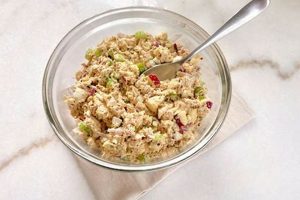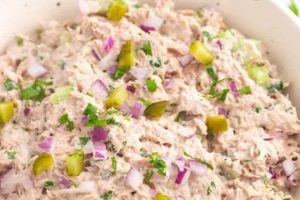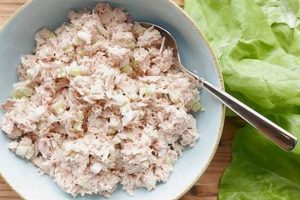Dishes combining cooked macaroni pasta, canned tuna, and a mayonnaise-based dressing represent a popular and versatile culinary option. These preparations often incorporate additional ingredients such as celery, onion, relish, hard-boiled eggs, and various seasonings to create a range of flavor profiles. This classic combination offers a convenient, budget-friendly meal suitable for picnics, potlucks, or quick lunches.
The affordability and ease of preparation contribute to the enduring appeal of this dish. Its adaptability allows for customization based on personal preferences and dietary needs. Variations can include the use of different types of pasta, the addition of vegetables like bell peppers or peas, and the incorporation of herbs and spices for enhanced flavor complexity. The dish’s historical roots likely stem from the increasing availability of canned tuna and convenience foods in the 20th century, solidifying its place as a familiar staple in many cultures.
Exploration of specific ingredient combinations, preparation techniques, and nutritional information will further illuminate the diverse world of pasta-tuna salads and offer practical guidance for culinary enthusiasts.
Tips for Exceptional Macaroni Tuna Salad
Achieving a flavorful and well-balanced macaroni tuna salad involves attention to detail in ingredient selection and preparation techniques. The following tips offer guidance for creating a superior culinary experience.
Tip 1: Pasta Perfection: Opt for small pasta shapes like elbows, shells, or rotini. Cook pasta al dente to maintain texture and prevent a mushy salad. Rinse cooked pasta under cold water to stop the cooking process and cool it down quickly.
Tip 2: Tuna Selection: Choose high-quality canned tuna packed in water or oil, depending on preference. Drain the tuna thoroughly before adding it to the salad to avoid excess liquid.
Tip 3: Flavorful Enhancements: Incorporate finely diced celery, red onion, and sweet pickle relish for a classic flavor profile. Consider adding chopped hard-boiled eggs for richness and texture.
Tip 4: Dressing Mastery: Employ a mayonnaise base, but elevate it with additions like Dijon mustard, lemon juice, or apple cider vinegar for a balanced flavor. Greek yogurt can be incorporated for a lighter, tangier alternative.
Tip 5: Seasoning Secrets: Season the salad with salt, black pepper, and paprika. Experiment with fresh herbs like dill or parsley for added brightness. A dash of hot sauce can provide a welcome kick.
Tip 6: Chilling Time: Allow the salad to chill in the refrigerator for at least 30 minutes before serving. This allows the flavors to meld and enhances the overall experience.
Tip 7: Creative Variations: Explore different add-ins like chopped bell peppers, shredded carrots, or black olives to customize the salad. Consider using different types of pasta, such as ditalini or farfalle, for visual appeal.
By following these guidelines, one can create a macaroni tuna salad that is both flavorful and satisfying. Attention to these details elevates a simple dish to a culinary delight.
From classic preparations to innovative variations, macaroni tuna salad offers a versatile canvas for culinary expression.
1. Ingredient Quality
Ingredient quality significantly impacts the overall flavor and enjoyment of tuna macaroni salad. Subpar ingredients can result in a bland or unappetizing dish, while fresh, high-quality components elevate the salad to a culinary delight. Understanding the role of individual ingredients allows for informed choices that maximize flavor and satisfaction.
- Tuna Selection
The choice of tuna plays a pivotal role. Opting for high-quality tuna packed in water or oil, rather than lower-grade options, ensures a richer, cleaner flavor. Solid or chunk light tuna offers a firm texture, while flaked tuna provides a softer consistency. Draining the tuna thoroughly prevents excess liquid from diluting the salad’s flavor profile.
- Fresh Produce
Crisp, fresh vegetables contribute significantly to the salad’s texture and flavor. Using recently purchased celery and onions, rather than older produce, ensures optimal crunch and avoids off-flavors. Proper storage of these ingredients maintains their quality until preparation.
- Mayonnaise Matters
The quality of mayonnaise directly influences the salad’s creaminess and overall flavor. Choosing a high-quality mayonnaise, rather than a generic brand, contributes a richer, more balanced flavor profile. Consider using mayonnaise made with real eggs and avoiding those with artificial flavors or preservatives.
- Pasta Perfection
Selecting the right pasta shape and ensuring proper cooking technique impacts the salad’s texture and ability to absorb the dressing. Small shapes like elbows or rotini are ideal. Overcooked pasta results in a mushy salad, while undercooked pasta lacks desirable tenderness. Cooking pasta al dente and rinsing it under cold water creates the ideal texture.
By prioritizing ingredient quality in every component, from the tuna to the vegetables and mayonnaise, one ensures a superior tuna macaroni salad experience. Careful attention to these details elevates the dish from simple fare to a truly satisfying culinary creation.
2. Flavor Balance
Flavor balance represents a critical aspect of successful tuna macaroni salad recipes. A harmonious blend of flavors elevates the dish beyond a simple combination of ingredients, creating a complex and satisfying culinary experience. This balance hinges on the careful interplay of several key taste components: richness, acidity, saltiness, and sweetness. Ignoring these elements can result in a one-dimensional salad lacking depth and appeal. For instance, an overabundance of mayonnaise can create an overly rich and heavy dish, while insufficient acidity can leave the salad tasting bland. Conversely, excessive salt or sweetness can overpower the delicate flavors of the tuna and other ingredients.
Achieving optimal flavor balance requires a nuanced understanding of ingredient interactions. The richness of mayonnaise provides a creamy backdrop, while acidity from ingredients like lemon juice or vinegar cuts through the richness, adding brightness. Salt enhances the inherent flavors of the tuna and vegetables, while a touch of sweetness, often from relish or a small amount of sugar, rounds out the profile. Real-world examples illustrate this principle: a classic tuna macaroni salad often incorporates dill relish for sweetness and tang, while a squeeze of lemon juice balances the richness of the mayonnaise. Similarly, some recipes use Dijon mustard, which contributes both acidity and a subtle heat, further enhancing flavor complexity.
Understanding the interplay of these flavors allows for informed recipe adjustments. If a salad tastes too rich, a splash of vinegar or lemon juice can restore balance. If the salad lacks brightness, a touch of sweet pickle relish can add depth. The ability to diagnose and correct flavor imbalances is a crucial skill for any cook aiming to create truly exceptional tuna macaroni salad. Ultimately, mastering flavor balance transforms a simple dish into a culinary creation that delights the palate and satisfies the senses. This principle extends beyond specific recipes, offering a foundational understanding applicable to a wide range of culinary endeavors.
3. Texture
Texture plays a crucial role in the overall enjoyment of tuna macaroni salad. A successful recipe balances contrasting textures to create a more satisfying sensory experience. The interplay of creamy, crunchy, and firm elements distinguishes a well-executed salad from a monotonous one. Consider the foundational element: pasta. Overcooked pasta results in a mushy, unappetizing texture, while undercooked pasta offers an unpleasant firmness. The ideal texture is al dente firm to the bite yet tender. This requires precise cooking times and immediate cooling to halt the cooking process.
Beyond the pasta, textural variety comes from the other ingredients. Crunchy elements, such as finely diced celery and red onion, provide a counterpoint to the creamy mayonnaise base. These additions introduce textural complexity, preventing the salad from becoming overly homogenous. Other ingredients contribute to the overall textural profile. Flaked tuna offers a softer, more delicate texture compared to chunk tuna, which provides a firmer bite. Hard-boiled eggs, if included, introduce a slightly crumbly texture, further enhancing the variety.
The practical significance of understanding texture in tuna macaroni salad lies in the ability to manipulate ingredients and techniques to achieve the desired outcome. For example, blanching vegetables before adding them to the salad can soften their texture while maintaining some crispness. Alternatively, using a coarser chop for vegetables preserves a more substantial crunch. Ultimately, skillful manipulation of texture elevates tuna macaroni salad from a simple dish to a more complex and enjoyable culinary experience. This attention to detail showcases a deeper understanding of culinary principles and results in a more rewarding sensory experience for the consumer.
4. Preparation Methods
Preparation methods significantly influence the final quality and taste of tuna macaroni salad. Specific techniques impact the texture, flavor development, and overall appeal of the dish. Careful consideration of these methods ensures a desirable outcome, while overlooking crucial steps can lead to a less satisfying result. For example, improperly cooked pasta can result in a mushy texture, negatively affecting the salad’s overall appeal. Similarly, neglecting to chill the salad adequately prevents the flavors from melding and developing fully.
Several key preparation steps contribute to a successful tuna macaroni salad. Cooking the pasta al dente is crucial for maintaining its texture and preventing it from becoming overly soft. Rinsing the cooked pasta under cold water stops the cooking process and cools the pasta quickly, further preserving its texture. Thoroughly draining the canned tuna prevents excess liquid from diluting the dressing and impacting the salad’s overall flavor. Properly combining the ingredients, ensuring even distribution of the dressing and other components, contributes to a balanced and enjoyable eating experience. Finally, chilling the salad for a sufficient period allows the flavors to meld and develop complexity, resulting in a more harmonious and flavorful dish.
The practical implications of understanding these preparation methods are significant. Consistent application of proper techniques ensures a consistently high-quality tuna macaroni salad. Conversely, neglecting these steps can lead to unpredictable results and a less satisfying culinary experience. Mastery of these methods allows for greater control over the final product, enabling adjustments based on personal preferences or specific recipe requirements. This understanding ultimately empowers individuals to create consistently delicious and well-balanced tuna macaroni salad, highlighting the direct link between preparation methods and the final quality of the dish. Attention to these details demonstrates a commitment to culinary excellence, even in seemingly simple preparations.
5. Presentation
Presentation, often overlooked in the context of seemingly simple dishes like tuna macaroni salad, plays a significant role in enhancing the overall dining experience. While flavor and texture undoubtedly remain paramount, visual appeal elevates enjoyment, transforming a basic meal into a more enticing culinary offering. Thoughtful presentation demonstrates care and attention to detail, elevating even a humble dish to a higher level of appreciation.
- Serving Vessel
The choice of serving dish significantly influences perception. A plain bowl provides a functional, albeit uninspired, presentation. Alternatively, a more aesthetically pleasing dish, such as a glass bowl or a platter, enhances visual appeal. Serving individual portions in small ramekins or on lettuce cups adds a touch of elegance and sophistication. Practical considerations also apply. A deep bowl better contains the salad during transport, while a platter facilitates serving larger groups.
- Garnishing Techniques
Strategic garnishing enhances visual appeal and can complement the salad’s flavors. Simple garnishes, such as sprigs of fresh parsley, dill, or paprika, add a touch of color and freshness. Slices of hard-boiled eggs, wedges of tomatoes, or a sprinkle of chopped chives contribute both visual interest and additional flavor dimensions. Over-garnishing, however, can detract from the salad’s appeal; restraint and careful placement are key.
- Contextual Considerations
Presentation considerations vary depending on the serving context. A casual backyard barbecue might call for a simple presentation in a large bowl, facilitating self-service. A more formal setting, such as a luncheon or buffet, benefits from a more refined approach, using individual portions and elegant garnishes. The context dictates the appropriate level of formality and the practical aspects of serving.
- Plating Techniques
Even a simple scoop of tuna macaroni salad can benefit from attention to plating. Using an ice cream scoop creates uniform portions and adds a touch of visual order. A slightly mounded presentation in a bowl or on a plate elevates the visual appeal compared to a flattened, uninspired scoop. For individual servings, a bed of lettuce adds color and texture, enhancing the overall presentation.
While flavor and texture remain primary considerations in tuna macaroni salad recipes, presentation should not be neglected. Careful attention to visual details, from the serving vessel to the garnishes and plating techniques, elevates the dining experience, demonstrating care and attention to detail. These elements, while often subtle, contribute significantly to the overall enjoyment of the dish, transforming a simple meal into a more aesthetically pleasing and satisfying culinary experience. This attention to presentation ultimately reflects a respect for both the food and the diner.
Frequently Asked Questions
This section addresses common inquiries regarding the preparation and enjoyment of tuna macaroni salad.
Question 1: What type of pasta is best suited for tuna macaroni salad?
Small pasta shapes, such as elbows, shells, rotini, or ditalini, are generally preferred. These shapes hold the dressing well and provide a pleasant textural contrast with the other ingredients. Larger pasta shapes can become unwieldy and may not distribute evenly throughout the salad.
Question 2: How can one prevent tuna macaroni salad from becoming watery?
Thoroughly draining the canned tuna before incorporating it into the salad is crucial. Excess liquid from the can can dilute the dressing and lead to a watery consistency. Additionally, ensuring the pasta is cooked al dente and cooled completely before mixing prevents excess starch from contributing to a watery salad.
Question 3: What are some healthy alternatives to traditional mayonnaise-based dressings?
Greek yogurt or a combination of Greek yogurt and mayonnaise offer a lighter, tangier alternative to traditional mayonnaise. These options reduce overall fat content while maintaining a creamy texture. Additionally, incorporating ingredients like avocado or mashed chickpeas can contribute creaminess with added nutritional benefits.
Question 4: How long can tuna macaroni salad be stored safely in the refrigerator?
Properly stored in an airtight container, tuna macaroni salad typically remains safe to consume for three to five days in the refrigerator. However, quality may begin to deteriorate after two days. Always ensure the salad is stored at a temperature of 40F (4C) or below.
Question 5: Can tuna macaroni salad be frozen?
Freezing tuna macaroni salad is generally not recommended. Mayonnaise-based dressings tend to separate upon thawing, resulting in an undesirable texture. The vegetables may also lose their crispness and become watery. It’s best to prepare and consume the salad within a few days for optimal quality.
Question 6: How can one enhance the flavor of tuna macaroni salad beyond basic ingredients?
Incorporating fresh herbs, such as dill, parsley, or chives, adds brightness and complexity. Spices like paprika or a dash of cayenne pepper introduce warmth and depth. Adding chopped pickles, olives, or capers introduces briny notes, while a squeeze of lemon juice or a splash of vinegar enhances overall flavor balance.
Careful consideration of these frequently asked questions ensures consistent, high-quality tuna macaroni salad preparation, contributing to a more satisfying culinary experience.
This concludes the frequently asked questions section. Additional recipe variations and serving suggestions follow.
Tuna Macaroni Salad Recipes
Exploration of this culinary staple reveals a dish offering both simplicity and versatility. From ingredient selection and preparation methods to flavor balance and presentation, careful attention to detail elevates tuna macaroni salad beyond basic fare. Understanding the interplay of textures, the importance of quality ingredients, and the impact of proper preparation techniques allows for consistent, high-quality results. The adaptability of tuna macaroni salad allows for endless variations, catering to diverse palates and dietary preferences.
Culinary exploration benefits from a thorough understanding of foundational principles. Application of these principles to seemingly simple dishes, such as tuna macaroni salad, demonstrates an appreciation for the art of cooking and elevates everyday meals to more satisfying experiences. Continued experimentation and refinement of techniques promise further enhancement of this classic dish, ensuring its enduring presence in culinary traditions.






